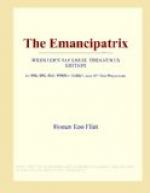His agent proceeded to drive straight over the rim and down the slope into the pit. His engine was quite stopped; like Smith, the geologist wondered just how the craft’s wheels were operated. Next he was holding his breath as the machine reached so steep a point in the slope that, most surely, no brakes could hold it. Simultaneously he heard the hiss and whine which seemed to indicate the suction device.
“It was a whole lot like going down into a placer mine,” the geologist afterward said; and in view of what next met his eyes, he was justified in his guess.
Down crept the machine until it was “standing on its nose.” The sun was shining almost straight down into the slope, and Van Emmon forgot his uneasiness about the craft in his interest in what he saw.
The bottom of the pit was perhaps twenty feet in diameter, and roughly hemispherical. Standing up from its bottom were half a dozen slim formations, like idealized stalagmites; they were made of some semitransparent rock, apparently, the tint being a reddish yellow. Finally, perched on the top of each of these was a stone; and surrounding these six “landmarks,” as Van Emmon called them, was the most prodigious display of wealth imaginable.
For the whole queer place was simply sprinkled with gold. Gold—gold everywhere; large nuggets of it, as big as one’s fist! Not embedded in rock, not scattered through sand, but lying loose upon the surface of that unbelievable orange snow! It was overwhelming.
The mysterious Sanusian lost no time. Operating some unseen machinery, he caused three shovel-like devices to project from the front of his machine; and these instantly proceeded, so swiftly that Van Emmon could not possibly watch their action, to pick up nuggets and stow them away out of sight in what must have been compartments in the hull. All this was done without any sound beyond the occasional thud of a nugget dropped in the scramble.
Suddenly the Sanusian wheeled his machine about and started hurriedly up the slope. Van Emmon judged that the chap had been frightened by something, for he took flight as soon as he reached the top of the pit. And—he left half a million in gold behind him!
This new flight had not lasted two minutes before the geologist began to note other objects in the air. There were birds, so distant that he could not identify them; one came near enough, however, for him to conclude that it was a hawk. But he did not hold to this conclusion very long.
The thing that changed his mind was another aircraft. It approached from behind, making even more noise than the other, and proceeded to draw abreast of it. From time to time Van Emmon’s agent turned his mysterious periscope so as to take it all in, and the geologist was able to watch his fill. Whereupon he became converted to a new idea:
The birds that Smith and he had seen had not been birds at all, but aircraft built in imitation of them.




